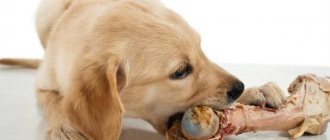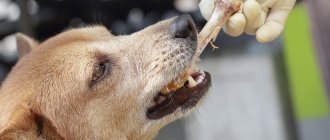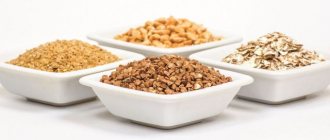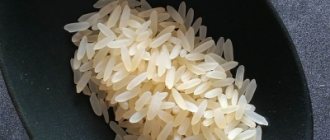Symptoms
If a dog swallows a bone and chokes, the animal will experience the following symptoms:
- the pet cannot swallow. This manifests itself during feeding. The pet begins to cough while swallowing food;
- The dog often swallows saliva. This is a protective reflex, the animal thus tries to swallow a foreign object;
- the animal whines. Most often this occurs after eating food. A foreign object can damage the intestine and pain occurs when eating food;
- cough;
- bile is secreted;
- the animal behaves lethargically, refuses food and games;
- wheezing appears when exhaling air;
- uncontrolled abundance of saliva. If an object is stuck in the throat, saliva accumulates and flows out.
Another symptom is the presence of blood in the stool.
A sign appears after a sharp object damages the intestine. Note! If any symptom appears, you should immediately contact a veterinarian.
Possible symptoms
Prevention measures
To prevent severe intestinal diseases and constipation, the dog is taught proper nutrition and a daily routine from the moment it arrives in the house.
What to do to prevent constipation in your dog:
- Feed the animal at the same time every day.
- Give large beef bones, no more than once a month.
- Do not introduce bone products into the diet of dogs younger than 6 months.
- Walk the dog twice daily, for at least an hour.
- Do not include the following foods in the animal’s diet: legumes, rice, sweets and baked goods.
- Stick to your vaccination schedule and take anthelmintic medications.
If a dog has weak intestinal motility, bones and heavy fatty foods are excluded from the animal’s diet..
High physical activity of your pet is a good preventive measure against constipation, including after eating bones. Moving on walks, the animal stimulates intestinal peristalsis, the food bolus moves along the tract without stopping.
The dog swallowed chicken bones
Chicken bones for dogs can only be used from broiler chickens. Birds raised in poultry farms have weak bones that do not form sharp edges when bitten. However, if your dog has eaten a chicken bone from domestic chickens, you need to know what to do in such cases. Village birds have a strong skeletal system, so it can damage the intestines and lead to the death of the animal.
Damage to bones for dogs
Causes
Bones, especially boiled ones, are rich in collagen; when exposed to high temperatures, extractive substances that have adhesive properties are released.
Once in the dog’s stomach, such food falls into a tight lump and sticks together. The intestines cannot push it out. The animal becomes severely constipated.
Other causes of insufficient bowel movements in dogs when eating bones include:
- Including chicken bones in your pet's diet.
- Lack of grains and plant foods in the animal’s diet.
- Weak motor activity of the pet.
- Increased sensitivity of the animal's digestive system
- Untimely quenching of thirst.
Experts advise against using bones in the diet of domestic dogs, even for the prevention of tartar . To remove plaque on dogs' teeth, they use special devices that are sold in pet stores.
The dog ate a fish bone
The fish bone is small in size. It is quite sharp and if it gets into the throat it can pierce its walls and cause pain to the pet. The first symptoms that an animal has swallowed a bone are insomnia and refusal to eat. Often the animal begins to whine while feeding. If a dog swallows a bone, every pet owner should know what to do in such a situation. You need to do the following:
- with the help of outside help, open the dog’s mouth wide and examine the throat;
- carefully examine the animal's teeth. Fish bones can get stuck between teeth;
- If the bone is noticeable, use tweezers to remove it.
Note! If there is no bone in the mouth and throat, and the dog continues to feel unwell, it is necessary to visit a veterinarian.
The dangers of fish bones
First aid for a pet
If the dog feels well, it is mobile, the appetite is not impaired, in this case, with constipation, you can try to help it at home. Treatment for constipation begins if there is no stool for more than two days.
At home you can do the following:
- Feed the animal with fermented milk products: yogurt, fermented baked milk, yogurt with the addition of any vegetable oil (no more than 1 tbsp.).
- Introduce grated vegetables into your diet: cabbage, broccoli, beets, pumpkin. A spoonful of olive oil is also added to them.
- At this time, refuse dry store-bought food or soak it in water.
- Double the walking time and let the dog off the leash so that he can move actively. This stimulates intestinal peristalsis.
- The animal should always have plenty of clean water in its bowl. A constipated dog drinks a lot and often. This helps liquefy the food bolus and make it easier to come out.
First aid for constipation in dogs is Vaseline oil. It is injected into the animal's mouth using a syringe without a needle twice a day.
Dosage: puppies - 0.5-1 tsp, adult dogs of small breeds - 1 tsp, medium-sized breeds - 1 tbsp. Large dogs are given up to 2 tbsp. l. oils in one go.
The dog ate a tubular bone
Tubular bones are very dangerous for the animal. They all form sharp edges. In addition to damage to the digestive organs, the following problems may occur:
- damage to the oral cavity when biting a bone;
- bones may contain harmful bacteria, which, once in the dog’s body, can lead to the development of infection;
- The dog can't go to the toilet. Bones lead to constipation, which also negatively affects the pet’s well-being.
The long bones of cattle can block the respiratory system, causing the animal to suffocate and possibly die.
Important! Tubular seeds retain their structure even after cooking. Also, when boiling, most of the harmful microorganisms do not die.
Are bones good for dog teeth?
Bone is a very hard substance, and dogs that chew on bones can sometimes suffer tooth fractures. The sharp edges of broken bones can cause bleeding gums and cuts in the mouth.
Hollow bones can also cause problems if they get caught in a dog's teeth; sometimes this causes quite a lot of trauma and dogs may require anesthesia to remove the bone.
Some people believe that bones can help keep your dog's teeth clean when he chews them, but there are other options for your pet's oral hygiene, including non-bone dental chewing and tooth brushing. Many of these options are also much safer.
Actions if your pet is choking
If a dog swallows a bone whole, you need to know what to do.
Puppies and small breeds
Bones for small breeds can be very dangerous. Puppies need to be especially closely monitored. You need to know what to do if your puppy eats a bone and problems arise. The algorithm of actions should be as follows:
- open the mouth and carefully examine the throat with a flashlight;
- Make sure the dog can breathe normally. Very often the bones block the airways;
- holding the animal by the hind legs, lift it slightly;
- If there are symptoms of suffocation, the puppy should be pressed to the knees and with sharp movements of the palm, press the diaphragm.
If nothing can be done, you must urgently go to a veterinary hospital for help.
Important! When assisting puppies and small breeds, it is necessary to take into account the fragile constitution of the animal's body. Too sudden and strong pressure can lead to a spinal fracture.
Large pets
You can help a large pet by pressing against the animal’s back and placing your palm below the chest and applying sharp compressions. The procedure is carried out until the pet spits out the foreign object.
Helping a large dog
If there are no symptoms of suffocation, you can pour 50 grams of sunflower oil into the dog’s mouth. It will facilitate the rapid passage of bones through the digestive organs.
FAQ
Below are some frequently asked questions. When it comes to dogs eating chicken bones, we always recommend contacting your veterinarian.
Now that you know what to do if your puppy just ingested chicken bones, you may have more questions. Below are some common questions many dog owners ask after their puppy eats chicken bones. If you think we missed something, write to us in the comments!
Are chicken bones dangerous?
Unfortunately, chicken bones are no different from other types of cooked bones and can be dangerous for dogs. They are very fragile, especially when cooked, and can easily break apart in your dog's powerful jaws.
Instead of a tasty snack, bones can turn into a mouthful of sharp objects that can damage your gums, hurt your throat, pierce your throat, or end up in your stomach and wreak havoc.
Chicken bones can also go the wrong way, causing choking and coughing. Dogs' stomachs can partially digest bones, but this takes time, during which time sharp pieces of bone can cause problems. The undigested portion can also get stuck in the intestines, causing a blockage.
Can chicken bones kill dogs?
Chicken bones are known to kill dogs. Rarely, but it happens. The worst cases are when the bones puncture the esophagus (esophagus). The esophagus runs from the mouth to the stomach, through the chest cavity, and to the lungs and heart.
Like all parts of the gastrointestinal tract, it is considered "dirty" - bacteria and other microorganisms are widespread. If anything, it is "dirtier" than the stomach - without the benefit of gastric juices, everything that passes through the mouth passes through the throat, carrying bacteria.
Thus, when the protective layers of the esophagus are punctured (“perforated”), bacteria can travel from the esophagus into the chest cavity. Even if you assume that the bone fragment will not cause any harm to the lungs or heart, the infection and inflammation resulting from the puncture of the esophagus can be serious and even fatal.
Can dogs eat raw chicken bones?
Although dogs eating raw bones is less dangerous, there can still be health problems.
Raw chicken bones are less dangerous to dogs than cooked chicken bones because they do not splinter as easily. However, that doesn't mean they can't cause problems, and if your dog grabs one, you should still follow these instructions.
This is true even if your dog eats chicken bones as part of his regular diet, although if they are sufficiently ground up the risk is very low. Many people feed their dogs raw, and it is not uncommon for dogs to catch and eat birds in your yard.
But has my dog eaten chicken bones before?
Unfortunately, just because a dog has gotten away with eating bones before doesn't mean he'll be fine the second time. While in the vast majority of cases a dog will do just fine at eating a bone, there is a chance they won't, so it's best to avoid it if possible.
Are chicken bones not a natural food for dogs?
It is true that dogs are generally well adapted to eating prey and their bones. Dogs have been eating bones for hundreds of years. So what's the difference now? Firstly, modern veterinary medicine means we have been able to learn more about why dogs die.
We can even use cameras to see what damage has been done to the digestive tract by eating bones - just because it's natural doesn't mean it's safe.
It is also thought that dogs are more likely to have problems with bones when they quickly swallow them instead of spending time chewing - perhaps because they are trying to "get away with it" or "hide evidence", or even just because that their owner is tugging on the leash, asking them to move on.
In any case, swallowing bones is more likely to cause problems than chewing them carefully!
Dog choked on a bone - first aid
If your dog chokes on something, take him to the vet immediately.
If your dog is choking, choking, rubbing his face, drooling, coughing or fluttering after eating chicken bones, you need to call the nearest open veterinarian to let him know you're coming and get there as quickly as possible.
Bones, especially chicken or pork ribs, can get stuck in your mouth. They can also get stuck in the back of the throat or below. It can cause pain, breathing problems and even death.
As long as your dog can breathe, it's not recommended to try to remove the bone at home - even if it looks too close, you could get injured and risk pushing it further.
When should I worry?
The first thing to look for is whether the bones are getting stuck in your mouth. This typically results in paws pawing at the mouth, excessive licking, and drooling. If the bone gets stuck further, you may see sneezing, coughing, and slapping.
Bones stuck in the esophagus can cause shallow breathing, pain, swallowing, or even vomiting. All of these signs may appear within the first ten minutes, but if the bone reaches the stomach, it may take an hour or more for the signs to appear.
If the bone reaches your stomach, the worst is over, but that doesn't mean you can completely relax. Perforation of the intestine is still possible, and this can cause peritonitis, which is very painful and requires prolonged hospitalization.
How long does it take for chicken bones to be digested and removed?
If your dog is doing well after the chicken bone escapade, you may be wondering when you can relax again. How long does it take to go through a chicken bone?
Well, it depends on the dog's age, breed, size and normal diet. Chicken bone usually goes away within 24 hours, but some dogs may take more than two days to go through chicken bones.
What other foods are not suitable for dogs?
There are other things your dog shouldn't eat, and some things that aren't a big deal. Chances are, if your puppy swallowed chicken bones, they could end up in other things as well.
Below are some recommended articles that we think are worth checking out if your pup has a bad habit of doing things he shouldn't.
Chocolate: Chocolate is toxic to dogs in all quantities. Nuts: Some nuts can be toxic to dogs. Pickles: Although pickles do not cause illness, they contain high amounts of salt and should be avoided. Poop: Dogs that eat poop do not usually get sick, but the behavior must be addressed. Grass: Your dog eating grass can be a sign of a nutritional deficiency and should be addressed.
The dog swallowed the bone without choking
In some cases, the animal will swallow the bone without causing any symptoms. In such cases, the following recommendations must be followed:
- Do not give the animal solid food for 3 days. If the bone is stuck, hard food can cause further tearing of the soft tissue;
- feed the dog liquid oatmeal. The dog should eat at least 500 grams of liquid porridge daily. It is recommended to add a few tablespoons of vegetable oil to the porridge;
- keep an eye on the stool. If the bone has not damaged the tissue, the animal should go to the toilet regularly. The remains of the foreign object will be passed out along with the feces.
It is also necessary to give the dog water 2 times a day. If the animal refuses, the water is filled with force. Lack of water can lead to dehydration.
Important! Some owners do not feed the animal for several days. Such actions are incorrect, since the bone will move through the empty digestive organs and in the process damage them.
The pet ate too many bones
If your dog has eaten too many bones, you need to know what to do to cleanse the intestines. Overeating is often accompanied by constipation. Therefore, it is recommended to increase the amount of fluid consumed. Using a small syringe, inject 50 grams of Vaseline oil into the mouth.
What to do if your dog gets constipated from bones
Many modern dog breeds have sensitive digestive systems. When choosing a natural diet, the owner has only two options: completely eliminate bones from the dog’s diet or prevent constipation if necessary. Complete exclusion of bones is fraught with the formation of plaque and tartar. Timely prevention is harmless and is based on the introduction of a natural supplement into the diet - slippery elm bark powder.
Note! Against the background of constant use of bones, as a hygienic treat and a toy, do not forget that to prevent constipation, the dog must receive a sufficient amount of water and active physical activity.
Slippery elm bark powder is an all-natural remedy that helps prevent and treat constipation or intestinal blockages in dogs. Once in the intestines, the active substances absorb liquid and turn into dense mucus, which envelops the bones and helps them move through the intestines.
Slippery elm bark is usually sold in capsule or powder form. If you notice signs of digestive problems, give the drug once a day until bowel movements return to normal. With a standard dosage, to treat constipation, it is enough to give your dog:
- 1/4 capsule for a small dog.
- 1/2 capsule for a medium dog.
- 1 capsule for a large dog.
To dose the drug, which is packaged in capsules, the gelatin shell must be opened and the contents poured onto a clean sheet. The powder is divided into equal parts. Without the gelatin shell, the powder oxidizes within 24 hours. If you have a small or medium-sized dog, it is wiser to purchase the drug in powder form, which is packaged in sachets or bottles and does not oxidize so quickly.
The powder cannot be given in its pure form, but syrup at home. It is necessary to mix the required amount of water and powder, heat the resulting solution to a boil. After 2–3 minutes of boiling, the solution is removed from the heat. When the liquid becomes warmer, add a teaspoon of honey to it and cool.
Important! The syrup is prepared for 2-3 servings and stored in the refrigerator.
The suspension is given to the dog 3-4 times a day until bowel movements normalize. The dosage of slippery elm bark syrup depends on the dog’s weight:
- For dogs weighing less than 10 kg, give 1-2 teaspoons at a time.
- Dogs weighing 10–20 kg are given 2–4 teaspoons at a time.
- For a dog weighing more than 20 kg, a single dose is 150–200 ml.
Important! Slippery elm bark may cause side effects such as vomiting and nausea. If you feel worse, you must stop taking the drug and immediately consult a doctor.
When to contact a veterinarian
The following factors may be reasons to contact a veterinarian:
- the dog whines while eating food;
- after going to the toilet, stool mixed with blood is discovered;
- The dog refuses food and behaves restlessly.
Visit to the veterinarian
After swallowing bones, especially tubular ones, experts recommend taking an x-ray to make sure that the foreign object has not caused damage to the soft tissues. If there are scratches and wounds, treatment and a special diet are prescribed.
Important! Bones that have damaged the intestine and cannot come out naturally on their own are removed by surgery.
Consequences
The consequences after eating bones can be different. Some large pets, after swallowing, digest a foreign object without harm to the body. However, there are often cases where bones damage the integrity of the digestive organs. In such cases, inflammation begins.
What not to do
If foreign objects are swallowed, the following actions are prohibited:
- should not induce vomiting. This can lead to mechanical damage to the digestive organs;
- do not use enemas or laxatives;
- Do not give your pet solid food to push through a foreign object.
It is forbidden to treat your pet yourself. Medicines should be used only after a doctor's prescription.
Predisposing factors
Let's figure out under what conditions and why such constipation occurs. The reason for its appearance is clear - eating bones by an animal is rarely good for the dog. And this, by the way, goes against the opinion of many breeders who do not miss the chance to feed their pet “yummy.” But sometimes good intentions turn into tragedy: the dog stops eating, loses weight, becomes lethargic and apathetic, and then may even die. And there are an annoying number of such cases in veterinary practice. Why does this happen?
In the digestive system of dogs, bones simply cannot be digested.
After all, their stomach is nothing like a shark’s, where even steel gradually dissolves! Moreover, wolves, which are relatives of modern domestic dogs, also do not chew the bones of animals they kill in the wild. The exception is their brain varieties, from where predators lick the bone marrow.
Thus, there is no need to feed this to your dog. Unless, of course, you want him to leave this mortal coil prematurely. But among the bones there are especially dangerous varieties, feeding on which often leads not even to constipation, but to internal bleeding and other “troubles.” These include beef, chicken and... fish. Alas, some owners either feed their pets this food waste themselves, or simply do not watch their dog, which is why it eats whatever and wherever it wants.
The trouble with fish waste is not even that the particularly thick and flexible bones easily pierce the walls of the esophagus (and often reach the trachea), as well as the stomach and intestines!
The problem lies in their ability to clump: they fall into large “bundles” in the lumen of the gastrointestinal tract, the consequences of which are extremely severe. Persistent constipation develops, from which only (!) surgery can save. Without it, the animal is doomed to death.
The situation with chicken and beef bones is approximately the same: when an animal gnaws them, the “delicacies” break into thin and long fragments. They can easily pierce the walls of the gastrointestinal tract, and also, being semi-digested, form lumps (which we just wrote about). Unlike the case with fish bones, it is theoretically possible to destroy them without surgery, but in reality this is not always possible.
How to keep your dog safe
In order for a dog to live a long time, it is necessary to reduce the risk of ingesting foreign objects. For this it is recommended:
- purchase items for play according to the size of the pet;
- When walking, wear a muzzle to prevent the dog from picking up prohibited objects;
- Give the dog only soft bones.
Neglected situations are difficult to treat.
Ways to prevent the problem
List of laxatives
A list of pharmaceutical drugs to combat constipation is presented.
| Name | Peculiarities | Price |
| Magnesia | Attracts liquid and has a strong peristaltic effect. Dilute in boiled water at the rate of 1-2 g of powder per 1 kg. | From 60 to 150 rubles. |
| Bisacodyl | Increases the volume of mucus in the intestines. Release form: tablets, rectal suppositories. | From 40 to 100 rubles. |
| Vetelakt | The growth of beneficial bacteria in the intestines is stimulated, and the “water content” of stool increases. Helps with long-term constipation. Dose - 2-3 ml per 10 kg. | 80-150 rub. |
| Senade | Used for symptomatic treatment. The tablet form is suitable for animals.
| 50-100 rub. |
| Vetasyl | dietary supplement Contains barley and plantain. Dosage - 1 capsule per 9 kg of weight. Sprinkle the animal's food. | 100 capsules - 1600 rub. |
Veterinarian recommendations
If your dog has swallowed bones, you must follow the following recommendations from your veterinarian:
- Cut the church candle into small pieces. Remove the wick and give to the dog in small portions. The wax will envelop the bone and gently remove it naturally;
- monitor the dog's well-being. If unpleasant symptoms do not go away within 24 hours, you should visit a specialist.
The dog requires careful care. Even if complications do not appear within several days, it is necessary to closely monitor the animal’s well-being in order to avoid possible infectious diseases.
Expert advice
You need to know what to do if your dog ate a chicken bone. Bones can lead to the death of a pet or damage to the digestive organs in a short time. If the animal is choking and refuses food, it is recommended to consult a specialist and not self-medicate.
What are the forecasts
The dog scratches its ear and shakes its head: why and what to do
Often, owners do not know what to do if the dog has eaten chicken bones, and for some reason they decide not to do anything. This should not be allowed under any circumstances, because inaction on the part of the owner can cost his pet his life.
External symptoms - vomiting, lethargic appearance
When a tubular chicken bone enters a dog's body, its sharp edges damage the walls of the organs. This leads to inflammation of the affected area and the appearance of free gas inside the body. The damaged organ wall no longer protects the stomach or intestines from harmful bacteria, so they easily penetrate inside and cause a bacterial infection. This leads to the death of the pet.
However, it is not only sharp bones that pose a danger (such as chicken or fish bones without meat). Even soft shaped pits, such as mango or plum pits, can be deadly. They do not directly damage the walls of internal organs, but lead to blockage of blood vessels and compress tissue. Eventually the damaged tissue dies (necrosis occurs) and a tear still forms.
Turkey bones
No! Turkey bones are strictly prohibited. By treating him to such a “delicacy”, you may simply lose your pet. During chewing, the long bones become very sharp and can severely damage the dog's intestines. As a result, the pet may die from internal bleeding.
Lamb bones.
Pork bones
No! Not only bones, even pork meat is not allowed for dogs. By eating raw pork, your dog runs the risk of becoming infected with various worms, and cooked pork is very fatty for pets.
There are cases when owners, having cooked jellied meat, rush to treat their pet to bones from it. Well, the good stuff shouldn’t go to waste, right? The result of such feeding is that, at best, you will be able to get away with a slight fright, namely Vaseline and an enema.
In the worst case, there is an operation during which the intestines are cut and the bones are removed from it. This is followed by the postoperative period, when the dog needs to be given the maximum amount of time and attention. Still want to treat your dog to some boiled pork bones? Many have already become convinced that such “savings” cost too much. Don't be one of them.











